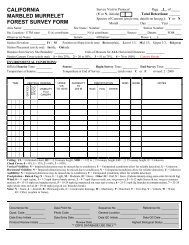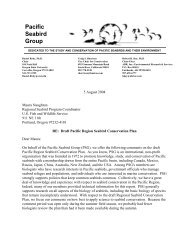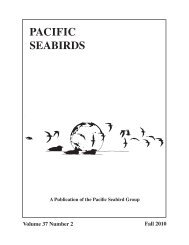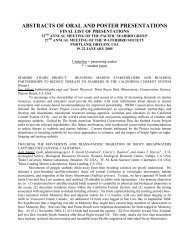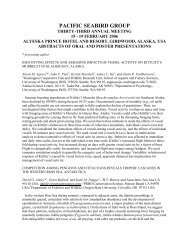PSG 2012 Hawaii abstracts - Pacific Seabird Group
PSG 2012 Hawaii abstracts - Pacific Seabird Group
PSG 2012 Hawaii abstracts - Pacific Seabird Group
You also want an ePaper? Increase the reach of your titles
YUMPU automatically turns print PDFs into web optimized ePapers that Google loves.
Naomi A. Bargmann *1, 2 , Veronica M. Padula 1 , and Douglas Causey 1, 2 , 1 nbargmann@gmail.com,<br />
Department of Biological Sciences, U Alaska Anchorage, 3211 Providence Drive, Anchorage, AK<br />
99508, 2 Environmental and Natural Resources Institute, U Alaska Anchorage, 3211 Providence Drive,<br />
Anchorage, AK 99508<br />
Stable isotope analyses are often used to infer migration patterns, diet composition and trophic status of<br />
seabirds. Many techniques are used to analyze stable isotopes among and within tissues, which potentially<br />
affect the results, their interpretation and thus the comparability of studies. One such difference is seen<br />
with the processing of lipids in samples. Tissues contain variable amounts of lipids that are depleted in<br />
the heavy carbon isotope ( 13 C) and may introduce a bias in these values. There is evidence that lipid<br />
extraction may affect other stable isotope ratios, such as δ 15 N. Consequently, correction factors need to be<br />
applied to appropriately interpret δ 13 C and δ 15 N values for individual species and tissue type. In this study,<br />
we collected seven species of seabirds from the Near Islands, the western most group of islands in the<br />
Aleutian Island archipelago. We sampled kidney, liver, heart and muscle samples from each bird and after<br />
freeze drying, individual tissue samples were divided into two subsamples. We left one subsample<br />
unaltered and extracted lipids from the other subsample using a 2:1 chloroform-methanol solution. We<br />
found that δ 13 C values varied among species and tissue type by as much as 1 %, while δ 15 N values<br />
remained fairly robust. Ultimately, the correction factors calculated for these seven seabird species will<br />
contribute to the growing body of knowledge regarding the effects of lipids on stable isotope ratios.<br />
NIGHT BIRDS RETURNING: A COLLABORATIVE EFFORT TO RESTORE SEABIRD NESTING<br />
HABITAT IN GWAII HAANAS NATIONAL PARK RESERVE AND HAIDA HERITAGE SITE<br />
Carita Bergman 1 , Jennifer Boyce 2 , Chris Gill 3 , Christine Gruman 4 , LukeHalpin 4 , Gregg Howald 5 , Laurie<br />
Wein* 1 , 1 Gwaii Haanas National Park Reserve and Haida Heritage Site, Box 37, Queen Charlotte, BC<br />
V0T 1S0, CANADA, Carita.Bergman@pc.gc.ca; 2 NOAA Restoration Center, Long Beach, CA; 3 Coastal<br />
Conservation, Tappen, BC; 4 School of Resource & Environmental Management, Simon Fraser<br />
University, BC; 5 Island Conservation, Vancouver, BC<br />
Gwaii Haanas National Park Reserve and Haida Heritage Site, cooperatively managed by the Haida<br />
Nation and the Government of Canada (Parks Canada), has identified introduced species as the primary<br />
threat to ecological integrity of the park reserve. Management of invasive species, including invasive rats,<br />
is an agency priority. In 2009, in an effort to restore 10 seabird nesting islands (~800 ha), a 5-year, 2-<br />
phase project to eradicate two species of rats was initiated. Islands were selected based on their historic<br />
seabird nesting values, with an objective to restore nesting habitat for Ancient Murrelets (translated as<br />
“night birds” from the Haida language, Synthliboramphus antiquus, a COSEWIC listed species) and two<br />
species of storm-petrels (Oceanodroma furcata and O. Leucorhoa). This project comprises three<br />
components: pre- and post- eradication monitoring (of both key ecosystem indicators and impacts to nontarget<br />
species), Phase 1 eradication (~100 ha using bait stations), and Phase 2 eradication (750 ha using<br />
bait broadcast techniques). The project is a collaboration between Gwaii Haanas, Island Conservation,<br />
Coastal Conservation, Simon Fraser University, and the Luckenbach Council. We present here a summary<br />
of pre-eradication monitoring, and Phase 1 eradication, completed in 2011. Modified eradication<br />
techniques dramatically reduced non-target species risk while still achieving the desired result. We see<br />
great potential for expansion of such restoration work both across lands managed Parks Canada Agency,



